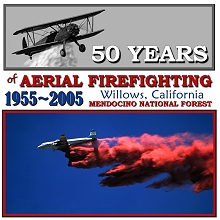|
SoCal FIREFIGHTERS PLUNGED BACK INTO FIRE SEASON?JANUARY 24 -- HIGHLAND, CA: Aircraft bailed from the South and headed back to California today to help about 600 firefighters with a fire in the hills northeast of San Bernardino. The Plunge Fire has been threatening about 500 homes, along with threatened and endangered species habitat in the area. Voluntary evacuations are in effect in parts of the community of Running Springs, and an evacuation center has been set up in Highland.
Winds have been gusting to 40 mph or more, pushing the fire into areas that haven't burned in decades.
The San Bernardino County Sun, which has a slide show of the fire online, reported that Incident Commander Norm Walker said he expected a wind shift today, and that if the Santa Ana winds died down then airtankers could be dispatched. He said plans in the meantime included building fireline with dozers and hand crews on the north side of the fire.
"We have about a mile to do, 25 feet wide, to make it safe,'' he said. "We think the main concern right now is Fredalba and Running Springs. If it goes down to Highland it will get into the Old Fire area, which is just grass right now.''
The Press-Enterprise reported that the fire started yesterday just after noon. It's burning in an area that's thick with chaparral and other heavy fuels.
The fire this morning was 10 percent contained at 400 acres, but tomorrow's weather is expected to hit 70º or better with wind gusts up to 50 mph. Fire managers expect the fire to spread southwest toward Highland. They cautioned, however, that if the gusty winds let up, local wind effects could cause a rapid 180-degree shift and push the fire upslope, threatening Running Springs, Fredalba, and Smiley Park. The Forest Service plans a community meeting this evening at 6 p.m. at the Hootman Senior Center in Running Springs.

STIHL RECALLS CHAINSAWSJANUARY 18 -- WASHINGTON, DC:
The U.S. Consumer Product Safety Commission and Stihl Inc. of Virginia Beach, Virginia, have announced a recall of the Stihl MS 192 T chainsaw.
 More than 23,000 of this model chainsaw were sold between January 2005 and July 2005. More than 23,000 of this model chainsaw were sold between January 2005 and July 2005.
Stihl has found that with this model chainsaw, a fuel line in the purge pump system may pull apart from a connector, allowing fuel to escape; a connection in the ignition grounding system may loosen and create a spark; and/or the springs in the clutch assembly may come out of position, allowing a spring of the clutch to be projected from the saw housing.
No incidents nor injuries have been reported.
The recalled chainsaws are model number MS 192 T, which is labeled on the side of the chainsaw's starter housing. Recalled saws include serial numbers 264371702 through 266087005, and the serial number can be located on the decal and is engraved into the housing.
If you have one of these saws, take it to an authorized Stihl dealer for a free repair.
For more information, call Stihl at (800)610-6677 between 7 a.m. and 8 p.m. ET Monday through Friday.

FEDS ASK FOR DISMISSAL OF AIRTANKER LAWSUITJANUARY 17 -- CASPER, WY: A federal judge is considering a request from the U.S. Department of Justice to dismiss a lawsuit against former aerial firefighting giant Hawkins & Powers Aviation and others over a fatal crash of a PB4Y-2 airtanker nearly four years ago.
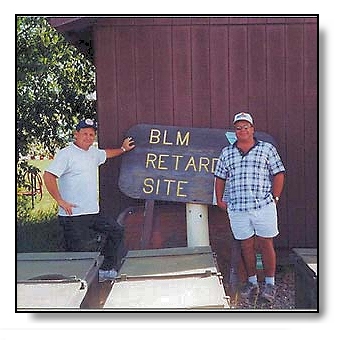
Milt Stollak and Rick Schwartz
|
Pilot Rick Schwartz of Montana and co-pilot Milt Stollak of California were killed in the crash on July 18, 2002, while fighting the 1,200-acre Big Elk Fire near Estes Park, Colorado. The lawsuit was filed in 2004 by relatives of the two pilots and names H&P; employees and a host of others; it claims, among other things, negligence and wrongful death.
TheDenverChannel.com reported that on January 5 attorneys asked Chief U.S. District Judge William Downes to either dismiss the case or drop certain defendants, including the U.S. Forest Service, from the case. Debra Fowler, senior aviation counsel for the U.S. Department of Justice, said the Forest Service had no obligation to supervise the airtanker's maintenance.
The Casper Star-Tribune reported that several attorneys argued that the case should not go to trial. "The happening of an accident doesn't mean someone was negligent," said attorney Rick Koehmstedt.
The NTSB investigation identified the probable cause of the crash as inflight failure of the left wing due to fatigue cracking in the wing's forward spar and wing skin, with a contributing factor of "inadequate maintenance procedures to detect fatigue cracking."
Judge Downes is expected to rule on the motions within several weeks. The lawsuit is scheduled to go to trial in about a month. Downes commented at one point on the age of the airtanker and said it had been around longer than he had.

10,000-ACRE NEBRASKA FIRE NOT THAT BIGJANUARY 17 -- HALSEY, NE: A wildfire that started Sunday morning on the Nebraska National Forest near Halsey was reported as 70 percent contained last night at 10,000 acres. But the Lincoln Journal Star reported today that fire managers have reduced their estimate of the fire’s size to about 5,600 acres based on a satellite survey conducted yesterday.
Information Officer Jerry Schumacher said the fire was likely human-caused.
He told the North Platte Telegraph that the Four Corners Fire started about nine miles southeast of Thedford. "Because of the weather and the wind, it spread fast enough to become a threat to firefighters."
Crews had about five miles of line left to build as of last night, and they expect to have the fire contained by this evening. Winds of up to 20 mph have been a problem; the fire's threatening forest and historic resources and range improvements. About 90 personnel remained on the fire last night.
Initial resources included 200 volunteer firefighters from 19 departments. Schumacher said the quick initial response by the volunteer fire departments made a huge impact on preventing the fire from growing any larger. The fire did reach some heavily timbered areas, but Schumacher said those areas had recently been thinned.
"None of us expect a fire in January," he said.

FIRE CREWS BUSY ACROSS TEXASJANUARY 16 -- FORT WORTH, TEXAS: Firefighters across north Texas were busy over the weekend; on Friday high winds pushed several grassfires burning in several counties, and red flag warnings have been in effect. One of the fires temporarily closed Interstate 35W in Fort Worth and another burned 900 acres and a hunting cabin in far north Parker County; a fire near Bryson grew to over 4,000 acres.
A grass fire that took off Saturday had burned 2,500 acres by yesterday afternoon and caused the evacuation of 62 homes. Possum Kingdom State Park was also evacuated. Les Wadzinski with the Texas Forest Service said the park was closed, and that three helicopters and six airtankers dropped on the fire till dusk yesterday.
The Fort Worth Star-Telegram reported that a 900-acre fire in Parker County destroyed a hunting cabin and a barn; up till this year, 1996 was the record for fires in north Texas. A 16,000-acre fire that year burned 85 homes in two days.
In Palo Pinto County, a fire that burned 300 acres and threatened five structures was at 70 percent containment by yesterday evening. Resources on that fire included five SEATs, a couple of helitankers, and one heavy airtanker, according to Bob Miller with the Texas Forest Service.
"It was one hell of an air show around five o'clock," he said. "The winds were really rocking."
Nationally, 31 new fires were reported yesterday. Four new large fires started in the South, and very high to extreme fire indices were reported in Texas and Kansas. KWTX-TV reported that a red flag warning was issued for central Texas through this evening, but rain was reported at the tanker base at Fort Smith, Arkansas earlier today.
A Unified Command including Custer's Type 1 team, a Florida Type 2 team, and a Type 2 incident commander from Texas, is operating from Granbury and Abilene, assisting local jurisdictions with management of existing fires that have burned about 22,000 acres -- plus initial attack on new fires. They reported seven new fires totaling 121 acres yesterday.
The Caddo Fire is about 50 percent contained at 2,500 acres. It's burning just north of Caddo and threatening structures; active fire behavior with torching was reported yesterday.
Both the 4,700-acre Burwick Fire west of Jacksboro and the 440-acre Lonestar Fire northeast of Mineral Wells are more than 90 percent contained.
nbc5i.com has an online collection of about 5 dozen Texas fire photos submitted by viewers.

2006 AIRTANKER CALENDARJANUARY 16 -- APPLE VALLEY, CA: This year's airtanker calendar is finished and available online, and it's possibly even cooler than last year's.

This year's calendar features 13 photos from Charles E. Stewart of Apple Valley, California, including current and vintage airtankers and helitankers. All 13 of the images can be viewed online at cafepress.com/wildfirenews/102588 and calendars can be ordered online.
The cost this year is $22 -- less than last year -- and they've been selling fast. Each month's photo measures 11 x 8½ inches and the calendar's printed on 100-pound high gloss paper. The cover photo -- one of the most dramatic tanker shots ever made -- is Stewart's image of Aero Union's Tanker 24 dropping on the Narrows Fire near Wrightwood, California, in August of 1997.

TWO FIRES BURNING IN COLORADO -- NOT.
NOVEMBER 21 -- DURANGO, CO: The Durango Herald reported today that the two fires burning near Mesa Verde National Park aren't burning at all. They were, in fact, contained back in July.
But news reports nationwide yesterday said crews were fighting two wildfires. The Colorado section of yesterday's Associated Press report was actually a months-old update on the 2,400-acre Trail East Fire and the Dwelling Fire that burned archaeological sites in the Ute Mountain Tribal Park south of Mesa Verde. The story also noted that rains had helped put down a 22,000-acre fire in southern Arizona.
Huh?
The reports ran yesterday afternoon on at least 45 TV news websites.
Reporters at KOAT-TV in Albuquerque were baffled. "KMGH in Denver called us and said it's on the national wire," said Jody Perry, who checked out the story yesterday. The Montezuma County Sheriff's Office verified that the report was a false alarm. The Associated Press Broadcast News Center later distributed a correction marked "high-level urgent" to hundreds of TV stations.
The report didn't worry Chris Buckman, the manager of the Durango Interagency Fire Dispatch Center. "I'm sure that nothing has been happening over there," she said. "I just talked to the Weather Service, and they would have known, too. There's no smoke anywhere."

SCHOOL FIRE EVACUATES 200 HOMESNOVEMBER 19 -- VENTURA, CA: A cooler onshore breeze that cut the Santa Ana winds back to about 20 mph helped crews make progress last night on the 3,700-acre School Fire between Ventura and Ojai, but about 200 threatened homes on the ridgetop were evacuated in the path of the fire.
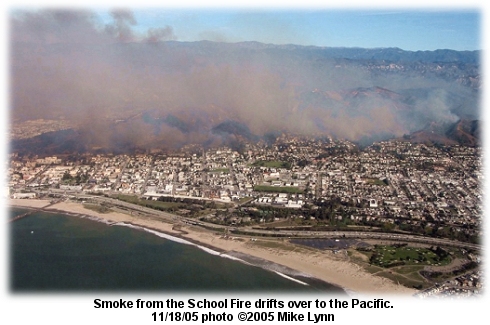
The fire was at 30 percent containment late last night and reported at 60 percent this evening. Fire managers hope to have it contained by Tuesday evening, but Ventura and the Avenue along Highway 33 are still threatened. Inspector Ron Haralson of the Los Angeles County Fire Department told the Associated Press that they still had a few hot spots this morning, but the fire had mostly laid down. More than 1,300 firefighters are working on the fire.
Thirty-foot flamelengths burned along the hillsides yesterday, and by early afternoon a large plume of smoke was lofting ash to the ocean. Helicopters and at least five airtankers worked the fire.
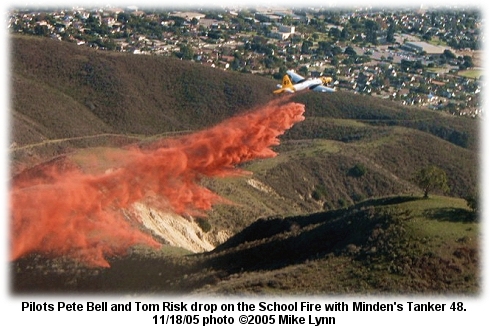
Winds are expected to continue through tomorrow morning at 15 to 25 mph with gusts near 35 mph.
Two commercial properties were confirmed destroyed; FEMA funds were authorized yesterday to help with suppression costs.

CALIFORNIA FIRE BURNS 500 ACRESNOVEMBER 18 -- VENTURA, CA: Strong winds have pushed a fire across 500 acres of brush in a rugged canyon area between Ventura and Ojai northwest of Los Angeles. Reported about 3:30 a.m. today, the fire's burning in an area that contains numerous oil pumps.
Joe Luna with the Ventura County Fire Department said about 200 firefighters were on the fire; according to an AP report, winds were gusting to 33 mph and a red flag warning had been issued.
The School Fire is threatening about 200 homes, along with powerlines and oil lease property.

CALIFORNIA STILL FACING FIRE DANGERNOVEMBER 15 -- SAN FRANCISCO, CA: The golden rolling hills of California may be officially out of fire season this week, but they're not yet out of fire danger.
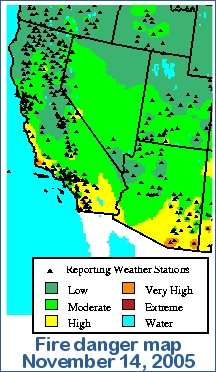 A red flag warning was issued yesterday for the unusually dry hills of Alameda, Contra Costa, and Santa Clara counties -- and yesterday was also the day that the California Department of Forestry and Fire Protection announced the official end of fire season. A red flag warning was issued yesterday for the unusually dry hills of Alameda, Contra Costa, and Santa Clara counties -- and yesterday was also the day that the California Department of Forestry and Fire Protection announced the official end of fire season.
In Contra Costa County, a brushfire pushed by gusty winds burned 65 acres, and more than 50 firefighters worked to contain it yesterday evening. KRON-TV reported several small grass fires in the Bay Area.
Assistant Chief Rick Hutchinson with CDF's Santa Clara unit said they're still staffing all 12 of their engines, even though they'd planned to release seasonal employees and staff just five engines by this time. He told the San Francisco Chronicle that the East Bay hills from San Ramon south to Santa Clara County are nearly as dry as they were in the summer.
Pleasant weather in the forecast for this week will affect central California and the southern part of the Bay Area differently from the rest of the Bay Area, because those areas are still very dry. "This weather situation is not unusual," said Hutchinson, "but it is about two to three weeks later than we would normally experience. We would usually see this in October."
FOX6 in San Diego reported that an extended period of extremely dry and windy conditions is settling over San Diego County. The National Weather Service also issued red flag warnings for that area through at least Thursday evening and perhaps into the weekend.

FIRE FUNDING CUTS CRITICIZEDNOVEMBER 08 -- WASHINGTON, DC: The White House proposal to eliminate $500 million in reserve funding for firefighting has met with heavy criticism from environmentalists and Western Democrats, who called the plan shortsighted and risky.
"This fund, developed on a bipartisan basis, ensured that firefighting costs could be met," said Senator Dianne Feinstein of California. If the 2006 season is worse than normal, she said, the Forest Service would have to cancel other projects such as fuels reduction in beetle-infested forests.
The proposal, according to an AP report, is part of a $2.3 billion package of cuts that includes reductions to other programs across government agencies. The administration also proposes shifting $17.1 billion from FEMA disaster relief accounts to hurricane response efforts such as rebuilding damaged highways, repairing levees, and fixing government buildings.
The Inland Valley Daily Bulletin called the plan disastrous, saying it's a trade-off that’s incongruous and outrageous.
‘‘We don’t want to pit one disaster against another,” said Ruth Wenstrom with the San Bernardino National Forest.
Bush has asked for $2.3 billion in cuts to other programs to aid in post-Katrina efforts, and the biggest cut would be the $500 million wildfire reserve. The Daily Bulletin said that would be "an ominous step for regional firefighting efforts, particularly when more than 10 million dead and dying trees in the local forest remain a gigantic fire hazard."
The $500 million reserve firefighting fund was approved by Congress last year in case the $700 million budgeted annually for firefighting is depleted. That happened in 2000, 2002, and 2003, when suppression costs exceeded $1 billion each year. Eliminating the $500 million fund is the single biggest cut in the $2.3 billion reduction package Bush proposed.
Scott Milburn with the federal Office of Management and Budget defended the proposal, contending that the $1.7 billion appropriated for fire management in the 2006 budget year would be adequate without the reserve. "With the 2004 and 2005 fire seasons having been relatively less active than normal, surplus funds sit in this account and can be rescinded without hurting the program," he said.
But members of Congress from Western states disagree. "This proposal breaks faith with rural folks all across the West," said Senator Ron Wyden of Oregon, "and will make it harder to find bipartisan legislative solutions in the future."
About a third of the total rescissions would come from natural resources and environment programs, according to GovExec.com, most of that from the fire funds plus $166 million from state clean water infrastructure funds, and millions more would be cut from National Park Service accounts.

VOLUNTEER FIREFIGHTER NUMBERS DECLININGNOVEMBER 07 -- PENN TOWNSHIP, PA: It took 26 fire companies from three counties last year to fight the fire at Dino's Grille, a two-story wood structure that ignited on a hot Tuesday morning in this town outside Harrisburg. Monte Supko, the local volunteer chief, still fumes about it; when he got to the fire, he contacted other volunteer departments in the area for assitance, but got just engines -- many with only one or two firefighters aboard.
By the time the fire was suppressed, according to a report by USAToday, the place was a smoking wreck. "A parade of half-million dollar firetrucks didn't help much," says Supko. "I got mad, because we've waited so long to address the problem."
Though the volunteer fire service saves taxpayers billions of dollars each year, with three-fourths of the nation's 1.1. million firefighters serving as volunteers, the number of volunteer firefighters has dropped nationally more than 10 percent over the last two decades.
It's partly an issue of time: potential volunteers have less of it, and firefighting now requires more of it. Most departments now require more than 100 hours of initial instruction, plus weekly drills and annual refresher courses. And then there's funding -- a growing number of volunteer departments rely on government funds to pay for a few fulltime firefighters or for health insurance or pensions.
"People have to realize that volunteerism isn't free any more," says Al Musicant, New Jersey director of the National Volunteer Fire Council. "You're going to have to give volunteers a stipend."
But the National Fire Protection Association and the Insurance Service Organization, which rates local fire risks, say there's no sign that call response times are increasing.

NEW STATION PENDING FOR KINGMANNOVEMBER 05 -- KINGMAN, AZ: Residents in and around Kingman will have a third fire station and a half dozen new firefighters in service come spring, according to a report by KOLD-TV. The station will be funded by a combination of private donations, grants, and FEMA payments, and Chief Wayne Eder says the station will serve several area subdivisions.
Local businesses donated more than $170,000 of the $1 million cost. New firefighters hired with FEMA funds will begin a 10-week training academy in January.
The Kingman Fire Department currently has 25 full-time and six volunteer staff; Kingman's two existing stations cover 24 square miles and respond to about 3,000 calls each year.

GREEN RIVER STATE WILDLIFE AREA RxFIREOCTOBER 28 -- HARMON, IL: Unusually dry conditions this year allowed tussock sedge to flourish and create excess dry fuels on the 2,565-acre Green River State Wildlife Area east of Rock Falls this year, but personnel with the Illinois Department of Natural Resources made a recent successful controlled burn of about 450 acres on the property.
Burning out invasive species and enhancing prairie habitat were two of the goals, according to Tim Schweitzer with the IDNR. He said part of the burn area had a layer of peat moss beneath the surface that was ignited and smoldered for a while because of this year's drought conditions.
A wildlife restoration area popular with hunters, hikers, and birders, the topography varies from flat to gently rolling. Swampy slough areas dominate nearly a third of the acreage, but the remaining portions are prairie restorations, open fields, cultivated areas, or timberlands, with much of the area planted and managed to provide wildlife feed and cover. Native prairie plants are found in many portions of the Green River Area, which includes about ten miles of equestrian trails. The property was acquired by the State of Illinois in 1940 with funding from the Federal Aid in Wildlife Restoration Act.
Doug Farster, IDNR assistant regional land manager, told the Sterling Daily Gazette that they do prescribed burns every spring and fall.

SPANISH FIREFIGHTERS WORK RxFIRE IN OREGONOCTOBER 27 -- SUMPTER, OR: Marc Castellnou is one of a group of firefighters from Spain who are researching and working on prescribed fire in the Elkhorn Mountains northeast of Sumpter. But they say the forests of eastern Oregon are not so different from those 6,000 miles away.
"We have a lot of forests like these," Castellnou says. He is working with Forest Service employees from Baker County and 16 firefighters from the Spanish Federal Fire Service in Catalonia, a province in northeast Spain. Catalonia is about the size of eastern Oregon, according to a story in the Baker City Herald, but is considerably more crowded, with about 13 times the population.
The Catalonian contingent will spend a couple weeks in eastern Oregon; this is the ninth year that Castellnou has brought colleagues to the West to study the use of prescribed fire in the U.S., and he values the experience. "At home they say to me, ‘when fall comes, the birds fly south and you fly west,'" he says. "We are adapting the skills we learn here to our own prescribed fire program."
"It's interesting to work with these folks," says Tom Fitzpatrick, Assistant FMO on the Baker Ranger District. "Their English is about as good as my Spanish, but it's been fun. And now I know how to say ‘chainsaw' in Spanish."
This year's fire season in Spain ranked among the most costly -- and deadly -- in history, as the country experienced its worst drought in 60 years. Eleven firefighters were killed in a fire in July, and fires burned about 300,000 acres across the country. The fires and fatalities resulted in new plans for fire suppression, including a national coordination center to handle project fires and harsh penalties for those who start forest fires; the man charged with starting the fire in July faces up to 20 years in prison.
Castellnou has worked for years on the issues. In the mid-1990s when he worked as a seasonal firefighter in Catalonia, he read about Americans using prescribed fire to reduce fuels. He realized that the practice had been common in Spain for centuries. But starting in the 19th century, many of the Basque people emigrated to the U.S. -- notably eastern Oregon.
"As a result," says Castellnou, "we lost our forest culture and our fire culture. Our grandfathers knew about prescribed fire, but we lost that knowledge." In 1997 Castellnou visited the Pacific Northwest to talk to fire experts. He met John Szymoniak on the Wallowa-Whitman National Forest, and Szymoniak invited him to return. Eight years later, Castellnou says, Catalonia's prescribed fire program is growing. They have proved, on thousands of acres in Spanish forests, the value of the prescribed burning techniques they've learned in Baker County.

CREWS FROM 14 STATES WORKING LOUISIANA FIRESOCTOBER 26 -- SLIDELL, LA: The state Department of Agriculture and Forestry is asking for firefighting help from 14 states because of the potential for wildland fires. "Conditions are right for major forest fires," said Gary Curcio, a fire behavior analyst and Fire Staff Specialist with the North Carolina Division of Forest Resources.
Crews from Maine, Arizona, Utah, Florida, North Carolina, Tennessee, Kansas, Colorado, Georgia, Virginia, Idaho, Oregon, Michigan, and Arkansas are working two-week tours in the parishes of St. Tammany, Washington, and Tangipahoa. Between September 28 and October 13 crews responded to 65 wildfires within the three parishes, the worst of which was a 65-acre wildfire northeast of Hammond.
"We're here to help them but not to interfere in their business," said Jerry Lambert, information officer for the fire mitigation team. "When they saw how much debris was on the ground, Louisiana went out and looked at it and said, 'We can't fight this; it's too big for us to fight.'"
The team expects to be in the area for at least three years. Lambert told the Slidell Sentry-News that many people are still burning debris despite the burn bans established after Hurricane Katrina. "We flew over St. Tammany," he said, "and there were fires everywhere. A majority of our fires in all the parishes have been from debris burning followed by arson."
The Southern Region is at Preparedness Level III and 17 wildfires were reported in Florida alone yesterday. Dry and windy conditions are creating high fire danger, with moderate to high fire danger reported across the entire region. November is expected to remain dry across the Appalachians south and westward across the Ohio and Tennessee River valleys to the Gulf Coastal Region, including virtually all of Louisiana. The southern third of Florida should also experience below-normal rainfall during November.

NEPA NECESSARY FOR RETARDANT USEOCTOBER 26 -- MISSOULA, MT: A federal judge has ruled that the U.S. Forest Service violated environmental laws when the agency failed to use the public review process under the National Environmental Policy Act. U.S. District Judge Donald Molloy in Missoula said the agency's use of retardant on fires without doing the formal environmental analysis of the effects of retardant on endangered species "was a political decision."
The environmental group FSEEE in Eugene, Oregon, sued the USFS in 2003 in an effort to force the agency to complete the NEPA analysis for the use of retardant.
An AP story in the Missoulian said Molloy determined that the USFS uses an average of 15 million gallons of retardant each year, and in busy fire seasons as much as 40 million gallons. He said between August 2001 and December 2002, retardant was dropped in water inhabited by endangered species eight times, six times on national forest lands.
Molloy rejected the agency's argument that using retardant was not a major federal action requiring the NEPA analysis, but rather a series of smaller actions by incident commanders without the time to complete a full environmental analysis.
"All evidence suggests that the USFS was told by other agencies to consult NEPA on fire retardant issues," Molloy wrote. "The decision not to involve NEPA appears to be a political decision. The only reason the USFS has provided for not applying NEPA is that there was no proposal for a major federal action. This is not a reasonable conclusion."
The USFS had said that retardant use did not constitute "programmatic activities" and that there is no effect on endangered species until retardant is actually dropped. But Molloy said the emergency exception didn't apply and was not an unexpected situation. "The use of fire retardant by the USFS is not unexpected but guaranteed," he said.
The judge's decision is online in a PDF file.
| 


